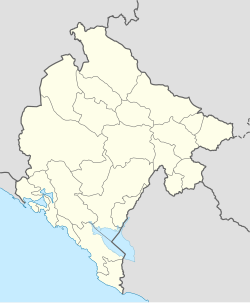Pljevlja
Pljevlja Пљевља | |
|---|---|
| Coordinates: 43°22′N 19°22′E / 43.36°N 19.36°E | |
| Kintra | |
| Dounsets | 153 |
| Govrenment | |
| • Mayor | Miloje Pupović (SNP) (SNP - NOVA - PZP) |
| Area | |
| • Total | 1346 km2 (520 sq mi) |
| Population (2011 census) | |
| • Total | 19,489 |
| • Density | 27/km2 (70/sq mi) |
| • Municipality | 30786 |
| Time zone | UTC+1 (CET) |
| • Summer (DST) | UTC+2 (CEST) |
| Postal code | 84210 |
| Aurie code | +382 89 |
| ISO 3166-2 code | ME-14 |
| Caur plates | PV |
| Website | http://www.pljevlja.me/ |
Pljevlja ( serbian Пљевља or Pljevlja ) pronounced [pʎɛ̂v̞ʎa]) is a toun an municipality locatit in the northren pairt o Montenegro. The ceety lees at a altitude o 770 m (2,530 ft). The heichest pynt o the municipality is on the Ljubišnja muntain at a altitude o 2,238 m (7,343 ft), while the lawest pynt is in the canyon o Tara river wi an altitude of 529 m (1,736 ft) abuin sea level.
In 2011, the municipality o Pljevlja haed a population o 30,786, while the ceety itsel haed a population o aboot 19,489. The municipality borders those o Žabljak, Bijelo Polje an Mojkovac in Montenegro, as well as the republics o Serbie an Bosnie an Herzegovinae. Wi a tot aurie o 1,346 km2 (520 sq mi), it is the third lairgest municipality in Montenegro.
Name
[eedit | eedit soorce]In Serbie an Montenegrin the toun is kent as Pljevlja or Пљевља; in Bosnie as Pljevlja; in Albanie as Pleva; an in Turkis as Taşlıca.
History
[eedit | eedit soorce]Prehistory
[eedit | eedit soorce]
The first human dounsets in Pljevlja’s region wur in the last Ice Age. The evidence, which is considered tae be the earliest in this pairt o Europe, can be foond in Mališina cave close tae the modren ceety o Pljevlja. Housomeivver, far richer are the dounsets frae the Stone Age foond in Medena Stijena.
Roman era
[eedit | eedit soorce]The first cultural fowk in this region are considered the Illyric tribes, Pirust, which livit thare till the Roman invasion o the 1st century AD. The Romans biggit thair awn ceety on the ruins o the Illyrie ceety an namit it Municipium S (S is the first letter o the name o the ceety that wis foondit on the ruins near Pljevlja's Komini suburb). The ceety wis the seicont lairgest Roman ceety in modren Montenegro efter Doclea. Municipium S wis the lairge tred an releegious centre o the upper Roman province o Dalmatie. A lairge nummer o valuable objects includin jewellery pieces, gless vases an pottery hae been foond in the ruins o the auld ceety. The maist valuable object is the Diatreta or cage cup, a gless vase trimmed wi blue gless threads which is considered tae be priceless an the anerly ane o its kynd in the warld.
Middle Ages
[eedit | eedit soorce]The Slavs eventually entered this region in the 6t century an biggit a ceety cried Breznik (Breznica), first mentioned in 822, namit efter the river which runs throu the ceety. The ceety blossomed ower the centuries an became ane o the main ceeties in the early Serbie state o Raška. Breznik wis on the main routes frae Dubrovnik, Trieste an Kotor tae Constantinople, Sarajevo an Belgrade an acause of that, the first customs wis opened in 1338. Frae 14t century ceety haed the dooble name Breznik an Pljevlja. Efter the breakdoun o Dušan’s empire, Breznik (Pljevlja) wis ruled bi mony rulers: frae 1368 tae 1373 bi Nikola Altomanović, 1373 tae 1435 bi Bosnie keengs an frae 1435 till 1 September 1462 bi Duke Stefan Vukčić when he lost the ceety tae the Ottoman Empire.
Ottoman rule
[eedit | eedit soorce]The new name, Pljevlja, wis no in uise for a lang time acause efter the Ottoman invasion the ceety wis renamit Taşlıca (rocky terms). Turks upgradit the ceety tae 'kasaba', a lairger Ottoman ceety athoot a fortress. The 15t an 16t centuries wur a period o hintle construction in the ceety: in 1465 a monastery wis foondit dedicatit tae the Holy Trinity; in 1569 Husein-paša’s mosque wis biggit an durin the 16t century the ceety got a sewage seestem. When the centre o Hercegovački Sanjak (Sanjak o Herzegovinae) wis muivit tae Pljevlja frae Foča in 1572, the ceety stairtit tae chynge rapidly: urban hoosin increased— 72 hooses in 1468, 150 in 1516, 300 in 1570; in the 17t century Pljevlja haed aroond 650 hooses in the ceety centre an ower 400 in the surroondin aurie. The first Muslim releegious schuil, Medresa, wis biggit in the 17t century; watter-wirks wur constructit in the 18t century. The Roushie consul visitit Pljevlja in the 19t century an wrote that Pljevlja wis a vera bonnie oriental ceety wi gardens an foontains, mosques an kirks an ower 800 hooses in the ceety centre (7,000 ceetizens) which made Pljevlja the seicond lairgest ceety in Hercegovački Sanjak beside Mostar. Efter twa big fires that burned the ceety centre tae the grund, the ceety's economy wis ruined. That wis the raison for displacin the centre o Hercegovački Sanjak tae Mostar in 1833. Efter 1833 the ceety stagnatit in baith an economic an cultural sense.

Modren history
[eedit | eedit soorce]In 1875, Efter a failed uprisin, mass emigration teuk place aroond Pljevlja in the direction o Užice, Valjevo an the Drina river basin.[1]
In 1878, Pljevlja wis occupee'd bi Austrick-Hungary lik Yenipazar sanjak. 5,000 airmy sodgers wi thair wives an childer came tae Pljevlja. That wis a beginnin o a new era for the ceety acause Austrians transformit Pljevlja intae a modren wastren ceety wi hotels, beukstores, theater an cultural events. The first modren drog store wis opened in 1879, a photo store in 1892, hospital in 1880 an beer factory in 1889 (Šećerović beer factory). Austrians athdrew frae the toun in 1908 an the Ottoman airmy returned tae it. In 1880 Pljevlja became the centre o Pljevaljski Sanjak (Sanjak o Taşlıca) which existit till 1912 when Pljevlja wis captured frae the Ottoman Empire. Serbie an Montenegrin airmies captured Pljevlja on the same day. In 1913 Pljevlja became a pairt o Kinrick o Montenegro, an efter Warld War I a pairt o Zetska Banovina in the Kinrick o Yugoslavie. Feenally, in 1945, efter Warld War II, Pljevlja acome a pairt o Montenegro.
Demographics
[eedit | eedit soorce]Pljevlja is the admeenistrative centre o Pljevlja municipality, which haes a population o 35,806. The toun o Pljevlja itsel haes 19,136 ceetizens, an is the anerly toun in the municipality wi a population o ower 1,000.
The municipality haes a majority o Serbs.
Population o Pljevlja (Toun):
- 3 Mairch 1981 - 16,792
- 3 Mairch 1991 - 20,887
- 1 November 2003 – 21,337
- 15 Apryle 2011 – 19,489
Ethnicity in 2011
| Ethnicity | Nummer | Percentage |
|---|---|---|
| Serbs | 17569 | 57.07% |
| Montenegrins | 7494 | 24.34% |
| Bosniaks | 2128 | 6.91% |
| Muslims bi naitionality | 1739 | 5.65% |
| Albanies | 17 | 0.06% |
| Croats | 16 | 0.05% |
| Ither | 115 | 0.42% |
| nae declared | 1448 | 4.62% |
| nae data | 205 | 0.55% |
| Tot | 30,786 | 100% |
Sichts
[eedit | eedit soorce]

The main featurs are :
- Husein Pasa mosque
- Sahat Kula, near mosque
- the Roman ceety Municipium
- Bosnian Stećci (monoliths)
- the Monastery o the Holy Trinity
- Saunt Petka’s kirk (Crkva Sveta Petka)
- the auldest heich schuil in Montenegro (Tanasije Pejatović Heich Schuil),
- Šećerović hoose.
- Kirk Saunt Ilija
Economy
[eedit | eedit soorce]Pljevlja is ane o the main economic ingines o Montenegro an aw. The anerly thermal pouer plant in Montenegro, which provides 45% o the electric pouer supply for Montenegro, is situatit ootside Pljevlja as well as the biggest coal mine wi 100% o the coal production in Montenegro. Zinc an lead can be foond in Šuplja stijena mine. The richest municipality wi forest in Montenegro is Pljevlja an its lummer industry. Agricultur is widespread in the whole municipality. Pljevaljski sir (Pljevlja's cheese, frae Пљеваљски сир) is considered a delicacy. Thare is big potential for ecological an winter tourism.
Transport
[eedit | eedit soorce]The main transit road connections are:
- tae Sarajevo in Bosnie an Herzegovinae
- tae Belgrade in Serbie
- tae Podgorica an the rest o Montenegro athort a brig ower Tara river
See an aw
[eedit | eedit soorce]References
[eedit | eedit soorce]- ↑ Jovan Cvijić, Balkansko poluostrvo i južnoslovenske zemlje /Balkan Peninsula and South Slav Countries/ (Belgrade: Zavod za izdavanje udžbenika, 1966), pp. 151-152.
Freemit airtins
[eedit | eedit soorce]| Wikimedia Commons haes media relatit tae Pljevlja. |
- http://www.pljevlja.me/
- Visit-Montenegro.com Archived 2013-09-21 at the Wayback Machine



